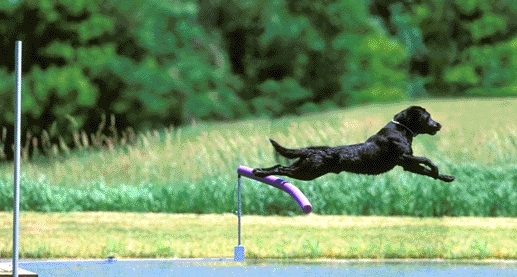|

A
Toy Motivated Sport
-
Its all
about getting the Toy. An un-interruptible desire to get the toy.
What I like to call “a Predatorily Instinct to GET the Toy”.
-
The
more the dog wants the toy the more the dog will do to get it.
-
The
dogs state of mind should be “They want the Toy so much; they’ll
do just about anything to get it.”
-
It’s
the difference between simply wanting to jump, retrieve and swim,
and doing what ever it takes get the Toy.
Energy
Requirements
Speed
then Height
-
Its the perfect combination
of Speed and Height that produces the big jumps.
-
This combination will
be different for each and every dog.
-
Work the Speed first.
When confident the Speed is at its Max, then work the Height as
a result of that speed.
Speed,
Hit the End of the Dock, Work the Lift
(in that order)
-
Speed:
a direct result of Confidence
and Drive
-
Hit
the End: accomplished through
Obedience (solid Sit / Stay), Stride Work, and Handler Technique
-
Lift:
Hurdle Work, Chasing the
Object
The goal is to
bring it all together while maintaining Confidence and Desire.
Ice
the Dog (technique)
Process
Benefit
The
JUMP LINE (definition)
Following
the JUMP LINE is Important
-
Learn to have your dog
run straight to the object. Make sure you the handler are not obstructing
that path.
-
Make sure that path
is perpendicular to the measuring line of sight. The more the path
is off perpendicular the more distance can be lost off the jump.
Focus
(definition)
Motivation
(definition)
Focus
and Motivation are Key
-
Learn
to build an uninterruptible concentration level. The dog must have
complete focus on the task at hand. Distractions
are common and will cause loss of desire. Have a plan and stick
to it.
-
A
strong desire or need to get the object is necessary for speed as
well as height if using the 'Chase' technique.
Confidence
(definition)
Trust
(definition)
It's
about Confidence and Trust
-
Always use the "Start
Short", "End Long" process. This will build a strong
level of confidence and trust. Once that is accomplished, the task
at hand becomes second nature. Distractions become minimal and the
focus will be set at performing the jump itself.
Drive
(definition)
-
a:
to dash, plunge, or surge ahead rapidly or violently
-
b:
to progress with strong momentum
-
c:
an urgent, basic, or instinctual need ,an impelling culturally acquired
interest or longing
Strive
to Build the Drive
-
A
strong, intense drive is the basis for a successful Dock Jumping
dog. Most dogs are born with natural drive, some more than others.
-
Dogs
with a strong, intense drive will have a much better chance to take
it to the next level than those with a lesser drive. Dogs bred from
field lines will generally have more drive, and will often exhibit
more energy. Dogs bred from show lines might not be as fast, and
will often exhibit less energy. One must continually strive to build
the drive.
-
Big Air Training
can be broken down in to 2 categories.
1) Introduction
Introducing something
new is a gradual process. It takes a certain amount of time for
a dog to learn new motions.
Small steps progressing
through to the final goal will produce results.
Use high number
repetitions.
2)
Improvement
Improving something
already learned. This is where you want to be careful not to over
train.
Use low number
repetitions. End the sessions wanting more.
-
Dogs are incredible
athletes and jumping comes naturally to most of them. They jump
to clear obstacles, they jump to express themselves, and YES, they
jump off docks.. They jump when they’re happy, when they’re
excited, and when they’re curious. Jumping builds a dogs confidence
and gives them an overall feeling of strength and energy.
-
Training assures the
dog will be the best jumper the dog can be. Weather your goal is
to entertain friends and family at a back yard barbeque at the cabin
or to achieve Gold at a National Championship, proper training will
assure your dog achieves that goal.
-
A properly trained dog
will utilize the entire dock to achieve maximum speed, learn to
jump from the 'end' of the dock and obtain just the right amount
of lift to achieve maximum height and distance.
-
Camaraderie
between the Dog and the Handler
starts
the minute you bring your puppy home and lasts their entire life.
Build a Bond: this is the foundation that allows your dog to learn
quickly. Continuously build and improve a working relationship that
structures your dogs thinking and willingness to learn.
Learn to Praise: interaction through Praise strengthens your ability
to interact with your dog. If that Foundation has been built, the
interaction will be an invaluable tool in the future. Confidence
and more Enthusiasm will be a result.
|